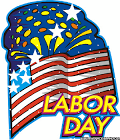This is a U.S.A. holiday.
 The passage of the Taft-Hartley Act in 1947 was the most consequential event in the history of the labor movement in the United States. The Act forms the foundation of modern labor law.
The passage of the Taft-Hartley Act in 1947 was the most consequential event in the history of the labor movement in the United States. The Act forms the foundation of modern labor law.
In the year after World War II, labor bosses were poised to become the most powerful group in the country. A wave of strikes in 1946 crippled the economy. Elsewhere, such as in Great Britain, labor union bosses achieved domination with substantial control (not just influence but control) of major political parties. In Britain the Labor Party’s leaders were chosen directly by the union bosses. In much of the world, the power of labor union bosses was growing to outsized power, too.
While concentration of power in the control of a few individuals has always been a problem in democracies, one usually thinks of such concentrations in the hands of business leaders or political leaders. Labor leaders as a threat were a new one.
After the strikes of 1946, Senator Robert A. Taft took on the task to updating the labor law to meet the challenges of the new era. President Truman, who had broken the railroad strike now had to ponder an uphill election battle with a key special interest group of the Democratic Party angry with him. In 1947 pledged his loyalty to the union bosses.
Taft’s tactical maneuvers were a masterpiece of Congressional leadership. He not only managed to steer his bill to passage with broad bipartisan support but also to override President Truman’s veto. In fairness, a Taft got a lot of votes from otherwise pro-labor supporters in Congress not just from his own tactical legerdemain but because of the excessive power of the Labor Union bosses. Their threats to ruin anyone who voted against them only served to underline a concentration of power that threatened the future of American democracy.
Aftermath: The election campaign of 1948 was the height of Labor Union power in America. President Truman proudly pledged his support of Big Labor, contrasting those bosses with the bosses of Big Business and declaring the Republicans to be under their thumbs. In Ohio, Big Labor went all out to defeat Senator Taft. They scored 1-1 with both Truman and Taft winning their elections. Even though Truman ran on a pledge to repeal Taft-Hartley, he never made a serious attempt to do so.
Taft-Hartley’s provisions survives (with later modifications_ as the foundation of modern labor law to this day.
More information on: The Taft-Hartley Act, The Strikes of 1946, The Railroad Strike, 1948 Election
Further information on: Labor Day.
Leave a Reply
You must be logged in to post a comment.